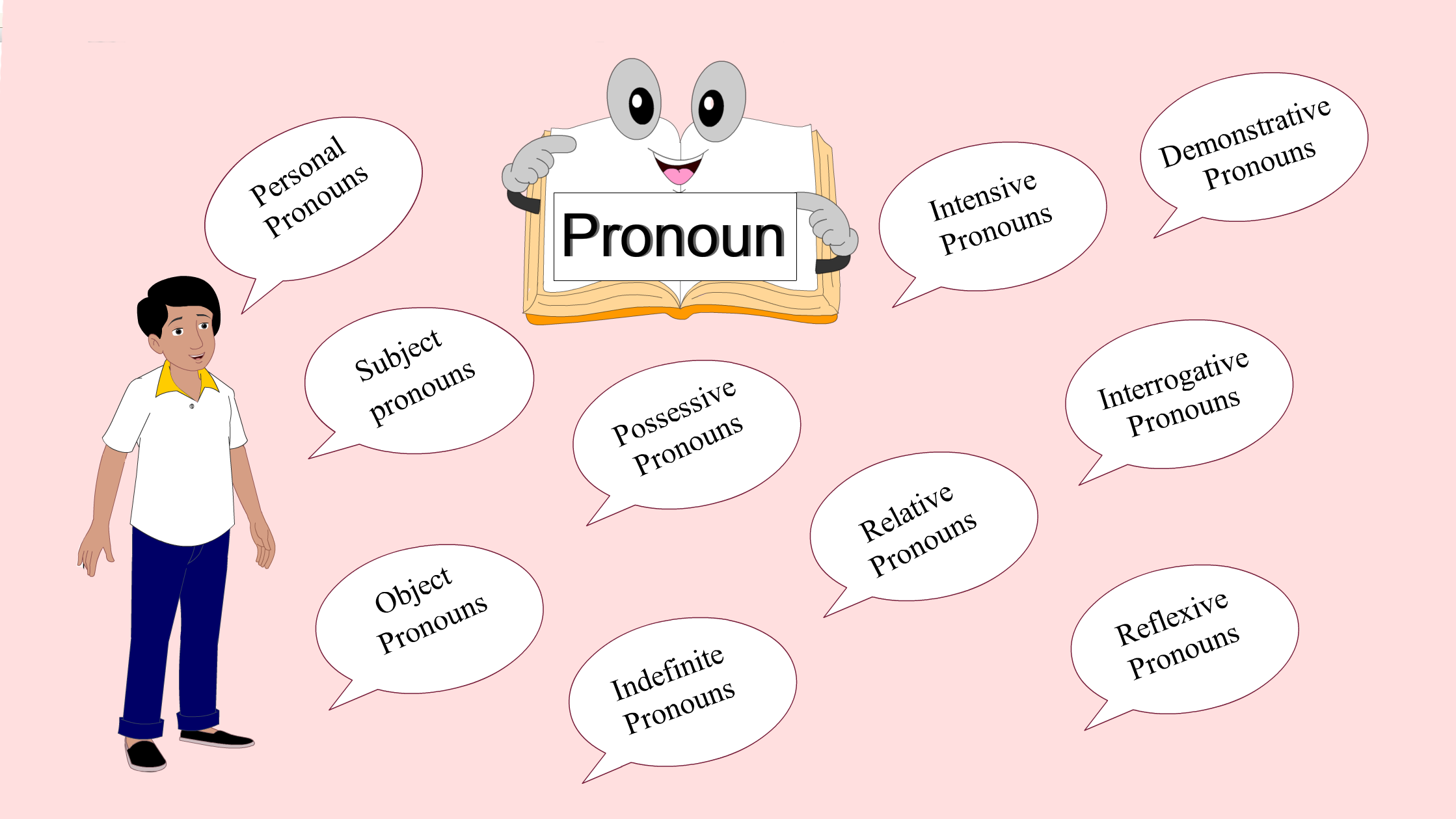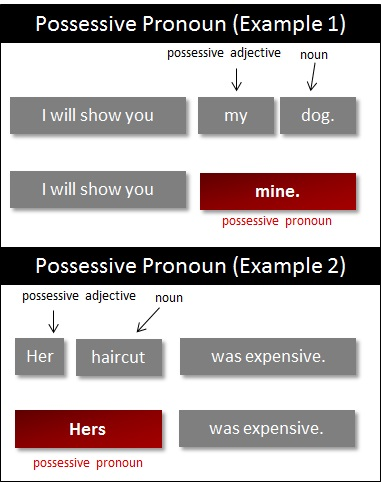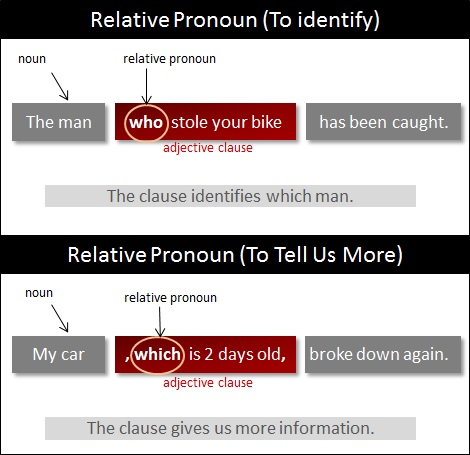Pronoun
 Look, Listen & Say
Look, Listen & Say
A pronoun is a word that replaces a noun in a sentence. Pronouns are used so that our language is not going to be monotonous with the same nouns being used repeatedly in a paragraph. (Noun এর পরিবর্তে ব্যবহৃত শব্দকে Pronoun বলে। একই বিশেষ্য বারবার ব্যবহারের ফলে আমাদের লেখা যেন একঘেয়ে হয়ে না যায়, সেজন্য আমরা Pronoun ব্যবহার করি।) Some examples of pronouns include I, me, mine, myself, she, her, hers, herself, we, us, ours and ourselves etc.
He, him, his and himself; all refer to a male person or something belonging to him.
They, them, theirs and themselves; all refer to a group or something belonging to a group.
The truth is that there are many different types of pronouns, each serving a different purpose in a sentence.
Classification of Pronoun:

Personal Pronouns
Personal pronouns can be the subject of a clause (part of a sentence) or sentence. (Personal pronouns একটি বাক্য বা বাক্যাংশের কর্তা হিসেবে কাজ করে।)
They are: I, he, she, it, they, we and you.
Example: “They went to the store.”
Personal pronouns can also be objective, where they are the object of a verb, preposition, or infinitive phrase. (Personal pronouns কোন ক্রিয়া বা কোন অসম্পূর্ণ শব্দশ্রেনির কর্ম হিসেবেও কাজ করে।) They are: me, her, him, it, you, them, and us.
Example: “David gave the gift to her.”
Subjective
Subject pronouns are often (but not always) found at the beginning of a sentence. (Subject pronouns সাধারণত বাক্যের শুরুতে বসে।) More precisely, the subject of a sentence is the person or thing that lives out the verb. (একটি বাক্যের কর্তা সেই বাক্যের ক্রিয়াকে সম্পাদন করে।)
I owe that person $3,000. I am living out that debt. I is the subject pronoun.
He and I had a fight. – This sentence has two subjects because he and I were both involved in the fight.
He broke my kneecaps. – He is the subject pronoun.
To him, I must now pay my children's college funds. – If you notice, the verb in this sentence, the action – is "pay". Although I is not at the beginning of the sentence, it is the person living out the action and therefore, it is the subject.
Objective
By contrast, objects and object pronouns indicate the recipient of an action or motion. They come after verbs and prepositions (to, with, for, at, on, beside, under, around, etc.). (যে সকল pronouns ক্রিয়া এবং prepositions-এর পরে বসে, এবং যাদের জন্য কোনো কাজ সম্পাদিত হয় তাদেরকে object pronouns বলে।)
The guy I borrowed money from showed me a crowbar and told me to pay him immediately.
I begged him for more time.
He said he'd given me enough time already.
I tried to dodge the crowbar, but he hit me with it anyway.
Just then, the police arrived and arrested us.
Subject vs. Object Pronouns
There is often confusion over which pronouns you should use when you are one-half of a dual subject or object. For example, should you say:
"Me and him had a fight" or, "He and I had a fight?"
"The police arrested me and him" or, "The police arrested he and I?"
Some people will tell you that you should always put the other person first and refer to yourself as "I" because it's more proper, but those people are wrong. You can put the other person first out of politeness, but you should always use the correct pronouns (subject or object) for the sentence.
A good test to decide which one you need is to try the sentence with one pronoun at a time. Would you say, "Me had a fight?". Of course not. You'd say, "I had a fight". What about, "Him had a fight?". No, you'd say, "He had a fight". So when you put the two subjects together, you get, "He and I had a fight". The same rule applies to the other example. You wouldn't say, "The police arrested he," or, "The police arrested I." You would use "him" and "me."
So the correct sentence is, "The police arrested me and him."
Possessive Pronouns
Possessive pronouns show ownership. The term covers both possessive pronouns and possessive adjectives. (যে সকল pronouns কোন জিনিসের মালিকানা দেখানোর জন্য ব্যবহৃত হয় তাদেরকে possessive pronouns and possessive adjectives বলে।)
Absolute possessive pronouns – mine, yours, ours, theirs, his, hers, its – are truly pronouns because they refer to a previously named or understood noun. They stand alone, not followed by any other noun.
Take a look at this sentence:
“You have your vices, and I have mine.”
There are two types of pronouns here: personal (you/I) and possessive (mine). There's also a possessive adjective (your).
Your is followed by the noun vices, so although we know that your refers to you, it is not the noun or the noun substitute (pronoun). Vices is the noun. In the second half of the sentence, however, the noun and the possessive adjective have both been replaced with one word – the pronoun, mine. Because it stands in the place of the noun, mine is an absolute pronoun whereas your is a possessive adjective that must be followed by a noun.
Pronominal possessive adjectives include- my, your, our, their, his, her and its. They are used as pronouns as they refer to an understood noun, showing possession by that noun of something. They are technically adjectives, though, because they modify a noun that follows them.
My money is all gone.
I gambled it all away on your race horse.
His jockey was too fat.
In all of these examples, there is a noun (money, race horse, jockey) that has not been replaced with a pronoun. Instead, an adjective is there to show whose money, horse and jockey we’re talking about.

| Possessive Pronoun | Example |
|---|---|
Mine |
This house is bigger than mine. |
Yours |
Is this yours? |
His |
Use his tomorrow morning. |
hers |
I like hers. |
Ours |
You can use ours. |
Yours |
Let me see yours. |
Indefinite Pronouns
These pronouns do not point to any particular nouns, but refer to things or people in general. (এই ধরণের pronouns কোন বিশেষ noun-কে না বুঝিয়ে সাধারন অর্থে কোন ব্যক্তি বা বস্তুকে বুঝায়।) Some of them are: few, everyone, all, some, anything, and nobody.
Everyone is already here.
The biggest issue with indefinite pronouns is determining whether they are singular or plural. Here is a list:
| Singular Indefinite Pronouns | Plural Indefinite Pronouns | Indefinite Pronouns Which Can be Singular or Plural |
|---|---|---|
|
|
|
Relative Pronouns
These pronouns are used to connect a clause or phrase to a noun or pronoun. (এই ধরণের pronouns বাক্যের একটি অংশকে কোন একটি noun বা pronoun-এর সাথে যুক্ত করে।) These are: who, whom, which, whoever, whomever, whichever, and that.
The driver who ran the stop sign was careless.

Intensive Pronouns
These pronouns are used to emphasize a noun or pronoun. (এই ধরনের pronoun অন্য কোন noun বা pronoun-এর উপর জোর দেওয়ার জন্য ব্যবহৃত হয়।) These are: myself, himself, herself, themselves, itself, yourself, yourselves, and ourselves.
He himself is his worst critic.
Demonstrative Pronouns
There are five demonstrative pronouns: these, those, this, that, and such. They focus attention on the nouns that are replacing. (এরা যে সকল noun-এর পরিবর্তে বসে তাদের উপরেই জোর দেয়।)
Such was his understanding.
Those are totally awesome.
Interrogative Pronouns
These pronouns are used to begin a question (এই pronoun-গুলি প্রশ্নের শুরুতে ব্যবহৃত হয়।) : who, whom, which, what, whoever, whomever, whichever, and whatever.
What are you bringing to the party?
Reflexive Pronouns
There is one more type of pronoun, and that is the reflexive pronoun. These are the ones that end in “self” or "selves." They are object pronouns that we use when the subject and the object are the same noun. (এই ধরনের আমরা তখনই ব্যবহার করি যখন কোন বাক্যের কর্তা ও কর্ম হিসেবে একই noun ব্যবহৃত হয়।)
I told myself not to spend all my money on new shoes.
-
My friend really hurt himself when he tripped on the stairs.
We also use them to emphasize the subject. Usually, the guy I borrowed the money from will send an employee to collect the money, but since I owed so much, he himself came to my house.
Pronoun Rules
There are a few important rules for using pronouns. As you read through these rules and the examples in the next section, notice how the pronoun rules are followed. Soon you’ll see that pronouns are easy to work with.
Subject pronouns may be used to begin sentences. (কোন বাক্যের শুরুতে Subject pronouns ব্যবহৃত হয়।) For example: We did a great job.
Subject pronouns may also be used to rename the subject. (কর্তাকে পুনরায় বোঝানোর জন্য ও Subject pronouns ব্যবহৃত হয়।) For example: It was she who decided we should go to Hawaii.
Indefinite pronouns don’t have antecedents. They are capable of standing on their own. (Indefinite pronouns কোন noun-এর পরিবর্তে বসেনা, বরং এরা স্বাধীনভাবে ব্যবহৃত হয়।) For example: No one likes the sound of fingernails on a chalkboard.
Object pronouns are used as direct objects, indirect objects, and objects of prepositions. (Object pronouns নির্দিষ্ট বা অনির্দিষ্ট কর্ম অথবা এর কর্ম হিসেবে ব্যবহৃত হয়।)These include: you, me, him, her, us, them, and it. For example: David talked to her about the mistake.
Possessive pronouns show ownership. (Possessive pronouns কোন জিনিসের মালিকানা দেখানোর জন্য ব্যবহৃত হয়।)They do not need apostrophes (’). For example: The cat washed its whiskers.



